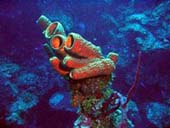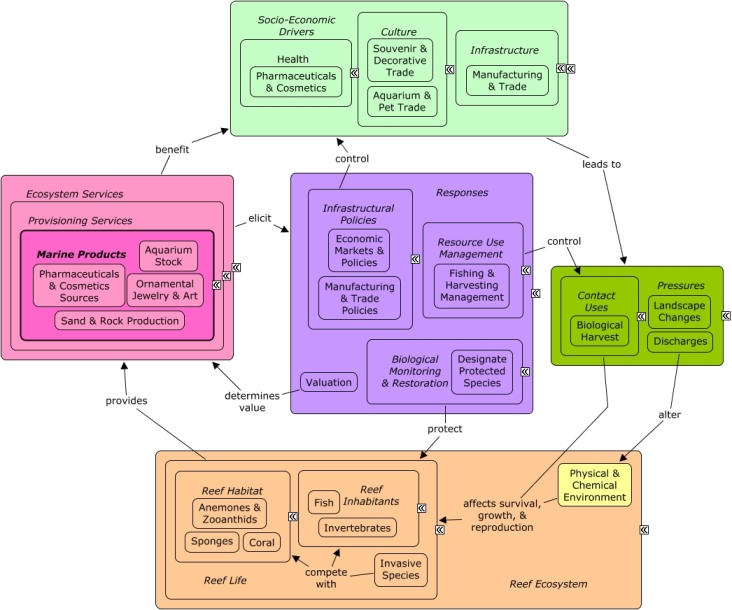ReefLink Database

Pharmaceuticals & Cosmetics Sources
Marine ecosystems provide sources and templates for pharmaceuticals, cosmetics, biochemicals, and other biomaterials.
CMap

CMap Description
A number of reef-dependent organisms may be harvested or collected for development or sale as marine products. A large number of pharmaceutical and cosmetic products have been derived from sponges, snails, and other marine organisms. Marine ecosystems are complex and species-rich with a vast array of predator-prey relationships that, coupled with the challenges of living in an aqueous medium, have resulted in a myriad of secondary metabolites with extraordinarily complex, hitherto unseen structures. From 1977�1987, the first decade of intensive marine exploration, about 2500 previously unknown metabolites were reported. Among the relatively small percentage of marine biochemicals that have been isolated, identified, and tested are pharmaceuticals, nutraceuticals, cosmetics, food additives, anti-fouling agents, adhesives, and physical and chemical templates in a variety of fields. Many of the sectors that benefit from marine products also create pressures on the reef ecosystem through coastal development, pollution, and harvesting. Overfishing, or accidental harvesting of non-target species, can disrupt the reef food web. Trade regulations and economic markets, including supply and demand, will influence the value of marine products. Species protections and fishing regulations can control the amount of potential stock that is actually harvested, or limit harvest of vulnerable taxa.Citations
More than 50 citations. Click here to load.
| Citation | Year | Study Location | Study Type | Database Topics |
|---|
Management Options
| Management Option | Description | Sources | Database Topics |
|---|---|---|---|
| Corporate Response: Invest & Co-finance Projects | Investing and co-financing projects that aim to conserve or restore habitats can be an effective means to preserving reef habitats as well as establishing positive working relationships between organizations. Investing in private sector projects will promote desired businesses and business practices, reducing barriers to entry and competitiveness as compared to traditional businesses and business practices to counterbalance advantages from undesired externalities. | World Bank Group. 2008. Biodiversity, Climate Change, and Adaptation. Nature based solutions from the world bank portfolio. The International Bank for Reconstruction and Development, Washington, DC. |
Aquarium Stock; Banks, Credit, & Securities; Biochemical & Genetic Resources; Biomedical Research Policies; Collaboration & Partnering; Corporate Responses; Economic Markets & Policies; Finance & Insurance; Finfish & Shellfish Stock; Food & Raw Materials; Funding & Donations; Funding & Incentives; Manufacturing & Trade; Manufacturing & Trade Policies; Marine Products; Ornamental Jewelry & Art; Pharmaceuticals & Cosmetics Sources; Provisioning Services; Resource Use Management; Tourism & Recreation |
| Economic Markets & Policy: Regulate International Trade of Reef Species | Many coral reef species are harvested internationally for a variety of markets including the aquarium trade, food, curios, jewelry and pharmaceuticals. The US is the largest importer for many of these markets. The US strictly limits extraction of stony coral and many reef species in its waters; but as a major importer and consumer of coral reef species, more actions can be taken to decrease the demand on international imports. Setting and enforcing regulations on what can be imported (such as Convention on International Trade in Endangered Species CITES) is one approach that has been taken. More information is needed, leaving room to collect trade data and assess the impacts of extraction techniques to find sustainable methods. Demand for species collected this way will be increased with greater transparency to consumers, which can be accomplished through certifications for environmentally cognoscente collectors and those using alternatives like aquaculture and coral farming. Continued participation in Asia Pacific Economic Cooperation (APEC) and International Coral Reef Initiative (ICRI) is also beneficial. | U.S. Coral Reef Task Force. 2000. International Trade in Coral and Coral Reef Species: The Role of the United States. Report of the Trade Subgroup of the International Working Group to the U.S. Coral Reef Task Force, Washington, D.C. World Resource Institute International Marinelife Alliance, editor. 1997. Sullied Seas. WRI, Washington D.C. U.S. Coral Reef Task Force. 2000. The National Action Plan to Conserve Coral Reefs. Washington, D.C. |
Accidental & Illegal Harvest; Aquaculture; Aquarium & Pet Trade; Aquarium Stock; Biological Harvest; Biological Monitoring, Mapping, & Scientific Research; Collaboration & Partnering; Coral; Corporate Responses; Cultural Policies; Designate Protected Species; Economic Markets & Policies; Environmental Education & Outreach; Invertebrate Harvest; Invertebrates; Live Collection; Manufacturing & Trade; Manufacturing & Trade Policies; Marine Products; Ornamental Jewelry & Art; Pharmaceuticals & Cosmetics; Pharmaceuticals & Cosmetics Sources; Political Pressure; Souvenir & Decorative Trade; Sponges; Stony Coral; Toxics; Wholesale & Retail Trade |
| Monitor & Research: Biological Status and Trends Monitoring | This activity produces long-term comprehensive information on sanctuary-wide status and trends of biological resources. Data that could be collected on coral reef communities includes but is not limited to species abundance and density, biodiversity, benthic cover, coral condition, growth, recruitment, predation, and grazing. Mangroves and seagrasses should also be monitored. With adequate baseline data, changes in community structure and biocriteria can be identified and restoration or protection efforts can be taken. | NOAA Marine Sanctuary Program. 2007. Florida Keys National Marine Sanctuary revised management plan. National Ocean Service, Key West, FL. |
Algae; Anemones & Zooanthids; Apex Fish Predators; Aquaculture; Aquarium Stock; Biochemical & Genetic Resources; Biocriteria; Biological Harvest; Biological Monitoring & Restoration; Biological Monitoring, Mapping, & Scientific Research; Bivalves; Calcareous Macroalgae; Contact Uses; Coral; Coralline Algae; Cyanobacteria; Decision Support; Echinoderms; Ecosystem Monitoring & Restoration; Finfish & Shellfish Stock; Fish; Fishing Sector; Food & Energy Policies; Hydrocoral; Invasive Species; Invertebrates; Large Herbivorous Fish; Lobster, Crab, & Shrimp; Mangroves; Marine Birds; Marine Products; Marine Vertebrates; Marine Worms; Microorganisms; Molluscs; Octocoral; Octopus & Squid; Ornamental Jewelry & Art; Pathogens; Pharmaceuticals & Cosmetics Sources; Physical Damage; Primary Production; Provisioning Services; Resource Use Management; Sea Turtles; Sea Urchins; Seagrasses; Seastars; Skeletal Coral; Small Herbivorous Fish; Snails & Conch; Sponges; Stony Coral; Tunicates; Wetlands; Whales & Dolphins |
| Resource Use Management: Develop Regulations for Sponge Fisheries | Sponges play a vital role on reefs, providing structure, food and filtration. Depending on the method of removal, this process can be very destructive to other reef fauna and habitat. Research is needed to compare impacts of different sponge fishing methods in different areas. | NOAA Marine Sanctuary Program. 2007. Florida Keys National Marine Sanctuary revised management plan. National Ocean Service, Key West, FL. |
Accidental & Illegal Harvest; Biochemical & Genetic Resources; Biological Harvest; Biological Monitoring, Mapping, & Scientific Research; Boring Sponges; Commercial Fisheries; Contact Uses; Culture; Cyanobacteria; Educational & Research Opportunities; Encrusting Sponges; Finfish Harvest; Fisheries & Hunting Policies; Fishing & Harvesting Management; Fishing Sector; Invertebrate Harvest; Live Collection; Marine Products; Microorganisms; Nutrient & Contaminant Processing; Pharmaceuticals & Cosmetics Sources; Physical Damage; Resource Use Management; Scientific Research; Sponges; Tourism & Recreation; Tourism & Recreation Policies; Trawling & Fishing Gear Damage; Tube, Barrel, & Finger Sponges |
| Resource Use Management: Develop Live Collection Regulations | Live collection is often more destructive than capture of food fishes because of the destructive methods used to remove live fish and invertebrates from the reef habitat. These methods include use of cyanide and explosives. Current methods should be assessed and alternatives should be developed or collection prohibited. | World Resource Institute International Marinelife Alliance, editor. 1997. Sullied Seas. WRI, Washington D.C. |
Accidental & Illegal Harvest; Aquarium & Pet Trade; Biochemical & Genetic Resources; Biological Harvest; Biological Monitoring, Mapping, & Scientific Research; Commercial Fisheries; Contact Uses; Educational & Research Opportunities; Finfish Harvest; Fisheries & Hunting Policies; Fishing & Harvesting Management; Fishing Sector; Invertebrate Harvest; Live Collection; Marine Products; Pharmaceuticals & Cosmetics Sources; Physical Damage; Resource Use Management; Scientific Research; Sponges; Toxics; Trawling & Fishing Gear Damage; Wholesale & Retail Trade |
Laws
| Legal Citation | Purpose of Law | Management Organization | Database Topics |
|---|
